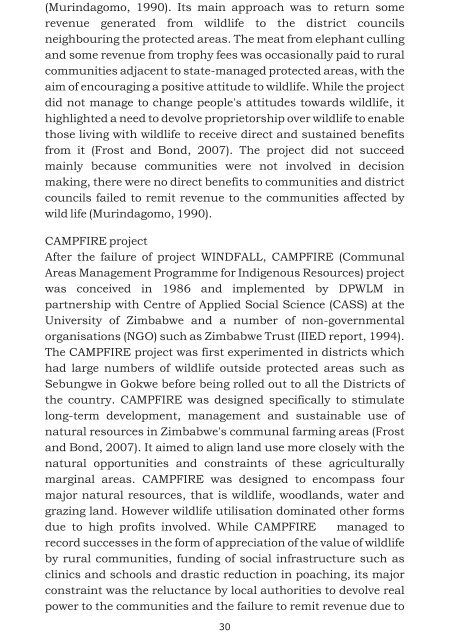Beneficiaries are actors too.pdf - Southern Institute of Peace ...
Beneficiaries are actors too.pdf - Southern Institute of Peace ...
Beneficiaries are actors too.pdf - Southern Institute of Peace ...
You also want an ePaper? Increase the reach of your titles
YUMPU automatically turns print PDFs into web optimized ePapers that Google loves.
(Murindagomo, 1990). Its main approach was to return some<br />
revenue generated from wildlife to the district councils<br />
neighbouring the protected <strong>are</strong>as. The meat from elephant culling<br />
and some revenue from trophy fees was occasionally paid to rural<br />
communities adjacent to state-managed protected <strong>are</strong>as, with the<br />
aim <strong>of</strong> encouraging a positive attitude to wildlife. While the project<br />
did not manage to change people's attitudes towards wildlife, it<br />
highlighted a need to devolve proprietorship over wildlife to enable<br />
those living with wildlife to receive direct and sustained benefits<br />
from it (Frost and Bond, 2007). The project did not succeed<br />
mainly because communities were not involved in decision<br />
making, there were no direct benefits to communities and district<br />
councils failed to remit revenue to the communities affected by<br />
wild life (Murindagomo, 1990).<br />
CAMPFIRE project<br />
After the failure <strong>of</strong> project WINDFALL, CAMPFIRE (Communal<br />
Areas Management Programme for Indigenous Resources) project<br />
was conceived in 1986 and implemented by DPWLM in<br />
partnership with Centre <strong>of</strong> Applied Social Science (CASS) at the<br />
University <strong>of</strong> Zimbabwe and a number <strong>of</strong> non-governmental<br />
organisations (NGO) such as Zimbabwe Trust (IIED report, 1994).<br />
The CAMPFIRE project was first experimented in districts which<br />
had large numbers <strong>of</strong> wildlife outside protected <strong>are</strong>as such as<br />
Sebungwe in Gokwe before being rolled out to all the Districts <strong>of</strong><br />
the country. CAMPFIRE was designed specifically to stimulate<br />
long-term development, management and sustainable use <strong>of</strong><br />
natural resources in Zimbabwe's communal farming <strong>are</strong>as (Frost<br />
and Bond, 2007). It aimed to align land use more closely with the<br />
natural opportunities and constraints <strong>of</strong> these agriculturally<br />
marginal <strong>are</strong>as. CAMPFIRE was designed to encompass four<br />
major natural resources, that is wildlife, woodlands, water and<br />
grazing land. However wildlife utilisation dominated other forms<br />
due to high pr<strong>of</strong>its involved. While CAMPFIRE managed to<br />
record successes in the form <strong>of</strong> appreciation <strong>of</strong> the value <strong>of</strong> wildlife<br />
by rural communities, funding <strong>of</strong> social infrastructure such as<br />
clinics and schools and drastic reduction in poaching, its major<br />
constraint was the reluctance by local authorities to devolve real<br />
power to the communities and the failure to remit revenue due to<br />
30


